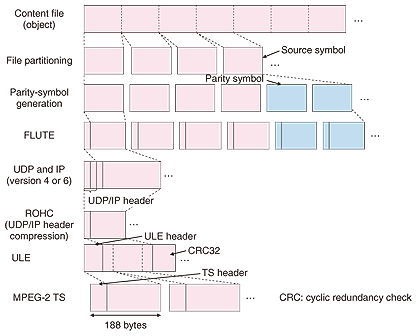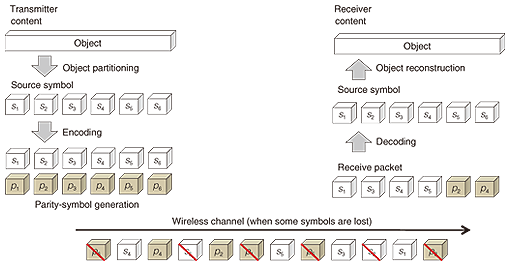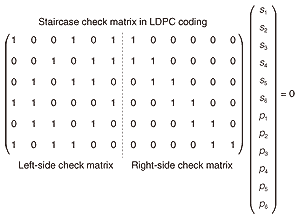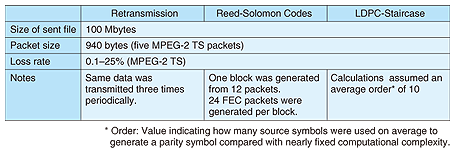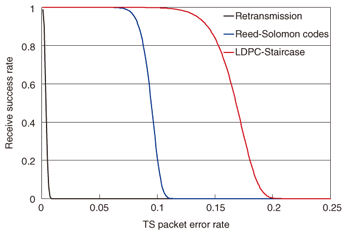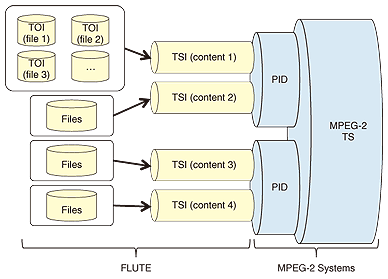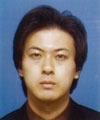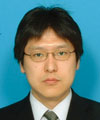 |
|||||||||||||
|
|
|||||||||||||
|
Feature Articles: Latest Trends of Multimedia Broadcasting Technologies for Mobile Terminals Vol. 9, No. 8, pp. 67–72, Aug. 2011. https://doi.org/10.53829/ntr201108fa10 Storage-based Broadcasting in Multimedia Broadcasting for Mobile TerminalsAbstractThis article outlines the technology behind storage-based broadcasting, which is provided in addition to realtime broadcasting in multimedia broadcasting for mobile terminals. It can deliver large files of multimedia content to users in an efficient manner via broadcast systems.
1. IntroductionStorage-based broadcasting services will be provided as well as realtime ones in multimedia broadcasting for mobile terminals using the ISDB-Tmm (integrated services digital broadcasting, terrestrial mobile multimedia) standard. Storage-based broadcasting is a new broadcast service that enables large files of multimedia content to be delivered to receivers over broadcast systems. In such services, users will be able to watch and enjoy content during the allowed period for viewing or using it. 2. Technologies for storage-based broadcastingThe ISDB-Tmm protocol stack is shown in Fig. 1 and the process flow from the content file to the transmission of TS (transport stream) packets*1 is shown in Fig. 2. Realtime broadcasting in ISDB-Tmm is provided by a packetized elementary stream (PES) on an MPEG-2 TS (Motion Pictures Expert Group-2 Transport Stream), the same as in ISDB-Terrestrial (ISDB-T). Storage-based broadcasting, on the other hand, uses a number of protocols for the transmission of various content files over the broadcast system. These protocols include AL-FEC (application layer, forward error correction) coding, FLUTE (file de1ivery over unidirectional transport), UDP/IP (user datagram protocol, Internet protocol), ROHC (robust header compression), and ULE (unidirectional lightweight encapsulation). Storage-based broadcasting also specifies a new file repair mechanism that uses the cellular network to recover lost data over the broadcast system.
3. AL-FEC codingIn storage-based broadcasting, AL-FEC coding is applied to content files to enhance their packet loss tolerance even in severe wireless channel conditions for mobile reception. AL-FEC coding generates source symbols and parity symbols from the content file (object) and applies time interleaving before transmission to them. The AL-FEC coding mechanism is outlined in Fig. 3. The AL-FEC coding partitions the object to be transmitted into source symbols, from which parity symbols are generated. Symbols that are lost in the wireless channel can be recovered from the source and parity symbols.
3.1 LDPC-StaircaseIn ISDB-Tmm, LDPC-Staircase (low-density parity check staircase) [1] codes are used as an AL-FEC coding scheme. LDPC-Staircase uses a parity check matrix for encoding and decoding. This check matrix consists of two matrices: a left-side matrix and right-side one. The left matrix indicates the source symbols, and the right one indicates the parity symbols. The left matrix is created by inserting 1s in elements selected by a random sequence and degrees. The right matrix is created by simply inserting 1 into matrix elements (i, i-1). An example of a parity check matrix is shown in Fig. 4. Here, the symbols S1-S5 and P1-P6 indicate source symbols and parity symbols, respectively.
3.2 Comparison of AL-FEC coding systemsTo select an AL-FEC coding algorithm for ISDB-Tmm, we evaluated three algorithms at the same computational complexity. These three algorithms were (1) DSM-CC (digital storage media command and control) (2) Reed-Solomon codes*2, and (3) LDPC-Staircase. The simulation conditions are listed in Table 1 and simulation results in terms of receive success rate (ratio of users who eventually received the full content to all users) versus TS packet error rate are shown in Fig. 5. The simulation results reveal that to achieve a receive success rate of 95%, the TS packet error rate must be less than 1% for DSM-CC but can be as high as 8% for Reed-Solomon codes and 13% for LDPC-Staircase. Thus, according to these results, LDPC-Staircase is the most tolerant algorithm to packet loss in the broadcasting system.
4. FLUTEThe FLUTE protocol manages content-transmission sessions in a broadcast network. An example of mapping from a FLUTE session to MPEG-2 Systems in ISDB-Tmm is shown in Fig. 6. In ISDB-Tmm, a set of information to be delivered to the users such as video or data is treated as a single object and managed by a Transport Object Identifier (TOI). One item of content managed by the Transport Session Identifier (TSI) is composed of multiple objects. This content is transmitted on MPEG-2 Systems by mapping the TSI to a Packet Identifier (PID)*3. FLUTE transmits a File Delivery Table (FDT) instance periodically to provide various types of attribute information about the content being transferred.
5. UDP/IP/ROHCAfter FLUTE, UDP, and IP headers have been added, ROHC is applied to packets as a header-compression protocol considering that the frequency of information changes in the UDP and IP headers is very low. ROHC treats a flow of IP packets having the same header information (next header, source/destination IP addresses, source/destination port numbers) as a single set (context) and transmits only updated information in a UDP/IP header. For example, the 28 bytes normally required for the UDP/IP headers in IPv4 can be compressed to as little as 1 byte. 6. ULEISDB-Tmm uses encapsulation by ULE to transmit content files converted to IP packets on MPEG-2 Systems. When this standard was established, a value of Ox22F1 was registered for the ROHC Ethertype in the ULE header by IEEE (Institute of Electrical and Electronics Engineers). 7. File repair7.1 File content repair mechanismFor storage-based service, it is important to provide reliable reception even when content is transmitted over a severe broadcasting channel. After AL-FEC decoding, portions of received content file that have been lost can be obtained via the cellular network, as shown in Fig. 7. In this file repair method, the receiver first identifies lost symbols in objects. It downloads source symbols needed for file repair from the file repair server over the cellular network and repairs the content. The file repair server transmits the lost content portions requested by the receiver using the content-range header in HTTP. The use of HTTP enables a generic HTTP server to be used as a file repair server. There are two types of timing for file repair mechanisms, manual repair and automatic repair, which are defined with the aim of making content viewing more convenient for users. Manual repair is performed when the user begins to view the content, and automatic repair is performed automatically in advance of viewing. Congestion in the cellular network is avoided by distributing the file repair timing among users.
7.2 Unequal error protectionThe early part of the content is likely to be viewed during file repair since manual file repair is being performed when the user starts viewing the content. If the packet loss tolerance of this early part could be increased by setting a high degree of redundancy by AL-FEC coding, it would be possible to achieve a smoother user experience. To do this, ISDB-Tmm uses unequal error protection (UEP), which enhances LDPC-Staircase coding. While the left-side matrix in LDPC-Staircase coding is normally arranged with 1s in a random manner, the UEP method notifies the receiver of the columns to give a high-density distribution of 1s. Applying UEP to LDPC-Staircase coding can increase packet-error resistance in early content by about 15% [2]. 7.3 Optimal packet selection for file repairFor file repair, requesting all source symbols would increase the traffic load in the cellular network. It is therefore important to use received symbols effectively and to efficiently reduce the number of repair-request symbols. ISDB-Tmm has a scheme for optimally selecting packets for file repair. This scheme reduces the number of repair packets by about 50% compared with all lost packets being requested. When converted to TS packet error rate, this equates to an improvement in packet loss resistance of 7–8%. 8. Concluding remarksStorage-based broadcasting is a new service that can deliver large files of multimedia content to users efficiently by using extensions to the ISDB-T standard. A storage-based service based on multimedia broadcasting is scheduled to be launched in Japan in spring 2012. References
|
|||||||||||||









